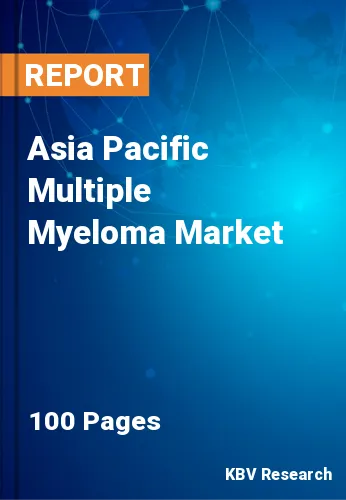The Asia Pacific Multiple Myeloma Market would witness market growth of 10.8% CAGR during the forecast period (2023-2029).
Diagnosing tumor-related abnormalities discovered through screening methods like radiography is the first step in the therapy procedures for myeloma. Radiotherapy is the first step in treating malignancies since it is a localized method that only affects the area surrounding the tumor. Radiological techniques are typically recommended as therapy choices at the asymptomatic stage of the condition. They are likewise utilized to treat pain brought on by bone deterioration in the latter stages.
Therefore, every cancer treatment must include radiotherapy. Recent developments in radiotherapy, such as its capacity to turn a circumscribed tumor into an in-situ vaccination, have increased the therapy's therapeutic window in several instances. In the treatment of multiple myeloma, radiotherapy has no viable substitute. With the disease's increasing incidence, it is therefore anticipated that the use of this method in multiple myeloma therapy will increase.
Southeast Asian countries are seeing a sharp rise in lymphoma prevalence in the region. The world's highest age-standardized rates of multiple myeloma (MM) incidence are also observed in Australia and its neighboring nations. In Australia, blood cancer affects 60,000 people. Similarly, other countries are also seeing an increase in the prevalence of hematopoietic malignancies. Leukemia, for instance, is now China's ninth-leading cancer-related cause of death. Blood cancer patients make up the third-highest percentage of patients worldwide in India. As a result, the demand for treatment methods in the region has risen due to the increased initiatives taken by different governmental and non-governmental groups in managing the illness prevalence.
The China market dominated the Asia Pacific Multiple Myeloma Market by Country in 2022, and would continue to be a dominant market till 2029; thereby, achieving a market value of $2,754.3 Million by 2029. The Japan market is estimated to grow a CAGR of 10.2% during (2023 - 2029). Additionally, The India market would experience a CAGR of 11.5% during (2023 - 2029).
Based on End User, the market is segmented into Hospitals, Clinics, and Others. Based on Disease Type, the market is segmented into Active Multiple Myeloma and Smoldering Multiple Myeloma. Based on Drug Type, the market is segmented into Protease Inhibitors, Monoclonal Antibody, Chemotherapy and Others. Based on countries, the market is segmented into China, Japan, India, South Korea, Singapore, Malaysia, and Rest of Asia Pacific.
Free Valuable Insights: The Worldwide Multiple Myeloma Market is Projected to reach USD 37.5 Billion by 2029, at a CAGR of 9.8%
The market research report covers the analysis of key stake holders of the market. Key companies profiled in the report include Novartis AG, Bristol Myers Squibb Company, Amgen, Inc., AbbVie, Inc., Sanofi S.A., Johnson & Johnson, Baxter International, Inc., Takeda Pharmaceutical Company Limited, Teva Pharmaceuticals Industries Ltd., and Pfizer, Inc.
By End User
By Disease Type
By Drug Type
By Country
Our team of dedicated experts can provide you with attractive expansion opportunities for your business.

